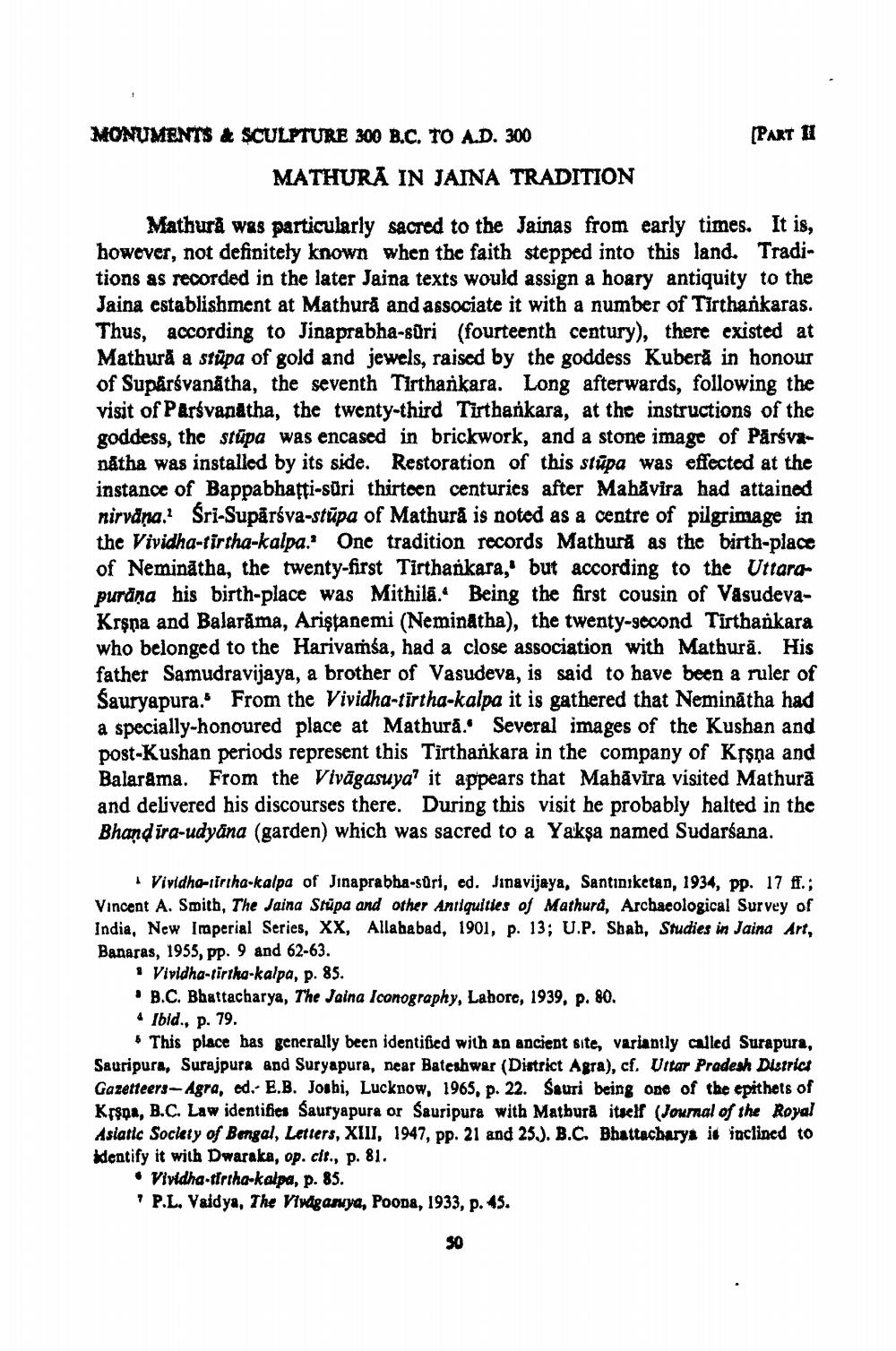________________
[PART 1
MONUMENTS & SCULPTURE 300 B.C. TO AD. 300
MATHURA IN JAINA TRADITION
Mathurd was particularly sacred to the Jainas from early times. It is, however, not definitely known when the faith stepped into this land. Traditions as recorded in the later Jaina texts would assign a hoary antiquity to the Jaina establishment at Mathura and associate it with a number of Tirtharkaras. Thus, according to Jinaprabha-sūri (fourteenth century), there existed at Mathură a stūpa of gold and jewels, raised by the goddess Kubera in honour of Supärsvanātha, the seventh Tirtharkara. Long afterwards, following the visit of Pārsvanatha, the twenty-third Tirthankara, at the instructions of the goddess, the stūpa was encased in brickwork, and a stone image of Pärśvanåtha was installed by its side. Restoration of this stúpa was effected at the instance of Bappabhatti-süri thirteen centurics after Mahävira had attained nirvana. Sri-Supārsva-stūpa of Mathură is noted as a centre of pilgrimage in the Vividha-Tirtha-kalpa. One tradition records Mathură as the birth-place of Neminátha, the twenty-first Tirthankara, but according to the Uttarapuräng his birth-place was Mithila. Being the first cousin of VasudevaKrsna and Balarama, Ariştanemi (Neminátha), the twenty-second Tirthankara who belonged to the Harivamśa, had a close association with Mathurā. His father Samudravijaya, a brother of Vasudeva, is said to have been a ruler of Sauryapura.. From the Vividha-tirtha-kalpa it is gathered that Neminātha had a specially-honoured place at Mathura. Several images of the Kushan and post-Kushan periods represent this Tirthankara in the company of Krsna and Balarama. From the Vivāgasuya' it appears that Mahāvira visited Mathura and delivered his discourses there. During this visit he probably halted in the Bhandira-udyāna (garden) which was sacred to a Yakşa named Sudarsana.
Vividha-iiriha-kalpa of Jinaprabha-sūri, ed. Jinavijaya, Santiniketan, 1934, pp. 17 ff.; Vincent A. Smith, The Jaina Stupa and other Antiquities of Mathurd, Archaeological Survey of India, New Imperial Series, XX, Allahabad, 1901, p. 13; U.P. Shah, Studies in Jaina Art, Banaras, 1955, pp. 9 and 62-63.
• Vividha-tirtha-kalpa, p. 85. . B.C. Bhattacharya, The Jaina Iconography, Lahore, 1939, p. 80. * Ibid., p. 79.
This place has generally been identified with an ancient site, variantly called Surapura, Sauripura, Surajpura and Suryapura, near Bateshwar (District Agra), cf, Uttar Pradesh District Gazetteers-Agra, ed.- E.B. Joshi, Lucknow, 1965, p. 22. Sauri being one of the epithets of Krsoa, B.C. Law identifies Sauryapura or Sauripura with Matburà itself (Journal of the Royal Asiatic Society of Bengal, Letters, XIII, 1947, pp. 21 and 25.). B.C. Bhattacharya is inclined to Identify it with Dwaraka, op. cit., p. 81.
• Vividha-tirtha-kalpa, p. 85. " P.L. Vaidya, The Vixigasuya, Poona, 1933, p. 45.




